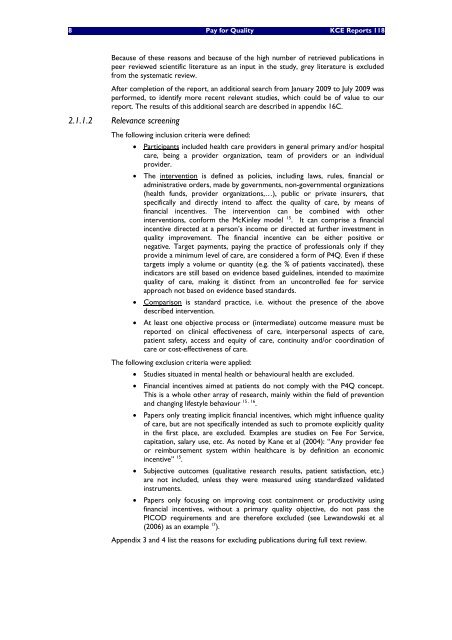Pay for Quality
Pay for Quality
Pay for Quality
You also want an ePaper? Increase the reach of your titles
YUMPU automatically turns print PDFs into web optimized ePapers that Google loves.
8 <strong>Pay</strong> <strong>for</strong> <strong>Quality</strong> KCE Reports 118<br />
Because of these reasons and because of the high number of retrieved publications in<br />
peer reviewed scientific literature as an input in the study, grey literature is excluded<br />
from the systematic review.<br />
After completion of the report, an additional search from January 2009 to July 2009 was<br />
per<strong>for</strong>med, to identify more recent relevant studies, which could be of value to our<br />
report. The results of this additional search are described in appendix 16C.<br />
2.1.1.2 Relevance screening<br />
The following inclusion criteria were defined:<br />
• Participants included health care providers in general primary and/or hospital<br />
care, being a provider organization, team of providers or an individual<br />
provider.<br />
• The intervention is defined as policies, including laws, rules, financial or<br />
administrative orders, made by governments, non-governmental organizations<br />
(health funds, provider organizations,…), public or private insurers, that<br />
specifically and directly intend to affect the quality of care, by means of<br />
financial incentives. The intervention can be combined with other<br />
interventions, con<strong>for</strong>m the McKinley model 15 . It can comprise a financial<br />
incentive directed at a person’s income or directed at further investment in<br />
quality improvement. The financial incentive can be either positive or<br />
negative. Target payments, paying the practice of professionals only if they<br />
provide a minimum level of care, are considered a <strong>for</strong>m of P4Q. Even if these<br />
targets imply a volume or quantity (e.g. the % of patients vaccinated), these<br />
indicators are still based on evidence based guidelines, intended to maximize<br />
quality of care, making it distinct from an uncontrolled fee <strong>for</strong> service<br />
approach not based on evidence based standards.<br />
• Comparison is standard practice, i.e. without the presence of the above<br />
described intervention.<br />
• At least one objective process or (intermediate) outcome measure must be<br />
reported on clinical effectiveness of care, interpersonal aspects of care,<br />
patient safety, access and equity of care, continuity and/or coordination of<br />
care or cost-effectiveness of care.<br />
The following exclusion criteria were applied:<br />
• Studies situated in mental health or behavioural health are excluded.<br />
• Financial incentives aimed at patients do not comply with the P4Q concept.<br />
This is a whole other array of research, mainly within the field of prevention<br />
and changing lifestyle behaviour 15 , 16 .<br />
• Papers only treating implicit financial incentives, which might influence quality<br />
of care, but are not specifically intended as such to promote explicitly quality<br />
in the first place, are excluded. Examples are studies on Fee For Service,<br />
capitation, salary use, etc. As noted by Kane et al (2004): “Any provider fee<br />
or reimbursement system within healthcare is by definition an economic<br />
incentive” 15 .<br />
• Subjective outcomes (qualitative research results, patient satisfaction, etc.)<br />
are not included, unless they were measured using standardized validated<br />
instruments.<br />
• Papers only focusing on improving cost containment or productivity using<br />
financial incentives, without a primary quality objective, do not pass the<br />
PICOD requirements and are there<strong>for</strong>e excluded (see Lewandowski et al<br />
(2006) as an example 17 ).<br />
Appendix 3 and 4 list the reasons <strong>for</strong> excluding publications during full text review.
















